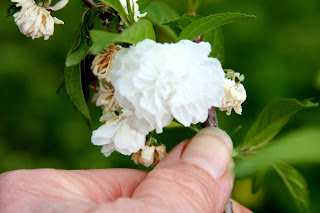Flowering Almond Shrubs are Prunus triloba and Prunus glandulosa
 |
| White Flowering Almond |
In the spring, Flowering Almond shrubs burst with double
flowers on 3 or four foot tall branches. The flowers are usually pink but there
are white ones available, too. The flowers look like carnations but they are
the size of a dime.
Prunus triloba is a member of the plum family of
trees and shrubs that includes cherries and the trees that produce almonds.
Since Flowering Almonds are so hardy and reliable, they thrive where more
vulnerable plants could be damaged by poor soil or harsh weather. They thrive
in zones 3 through 7.
At their maximum size, Flowering Almond shrubs can
grow 20-feet tall and 12-feet wide. They can be used as part of a flowering
hedge row or pruned into small trees. Be sure to prune and shape them right
after they flower.
When looking for them online and in stores you will
find both Prunus glandulosa and
Prunus triloba.
 |
| Pink Flowering Almond |
Both are native to
Asia. Prunus glandulosa is the dwarf form that stops growing at 6-feet tall and
wide. Its flowers can be either white or pink.
Because they spread over time, Flowering Almond Shrubs are often given to us by plant friends.
Our pink one came from Jan Farris who helped me pass the Master Gardener test 10 years ago. Our
white one came from Russell Studebaker who is our plant friend par excellence.
white one came from Russell Studebaker who is our plant friend par excellence.
Prunus triloba is the
one to choose if you want a screening shrub as it can grow over 15-tall.
To be sure you get
the double flowers, look for specific varieties. Prunus triloba
"Multiplex" and Prunus glandulosa "Rosea Plena" both have
double flowers. Also, ask about the
flower color if that matters to your color scheme.
Flowering Almonds like some protection from the
summer’s worst heat, so in our area choose a place that gets some shade. When
digging the planting hole, put in some compost for added drainage. Like most
members of fruit and nut tree families, they prefer slightly acid soil.
They develop some
drought tolerance as they mature but Flowering Almonds want moist roots.
Mulch
the surrounding area to keep the area weed-free and plant them away from the
lawn. Soak the plants if the soil is dry several inches down in late summer.
Good compost is about
all the fertilizer they need unless they seem to be failing. If the leaves are
turning yellow, use a water-soluble fertilizer to drench the plant from top to
bottom. To fertilize the roots, sprinkle
some crystals around the drip line (at the end of the branch where the leaves
drip when it rains) and water it into the ground thoroughly.
Generally speaking,
Flowering Almond shrubs are durable. If they are planted so close to other
shrubs that air cannot circulate around the branches though, they can get
aphids, scale, borers, spider mites and other insects and diseases. Be sure to
give them plenty of room.
If you notice
problems, start with the least harmful fix. Many insect problems can be cured
with a hard flow of water. It can knock off aphids, mites, etc.
The next level up is
insecticidal soap and horticultural oil. If those measures fail, move up to
applying an insecticide.
 |
| Old Wood vs New Wood |
The old adage “prune
after bloom” applies to Flowering Almonds. Next year’s flowers form on this
year’s growth so do any pruning and shaping now.
First, look for buds
on the old growth. Then cut the branch back to within a few buds of the old
growth. I put a photo of old versus new wood into my blog which you can access
through www.MuskogeePhoenix.com or directly through
www.allthedirtongardening.blogspot.com.
 |
| New Wood vs Old Wood |
Dead, broken and
diseased wood can be removed at any time. If you are shaping or rejuvenating an
old shrub, take off only one-third of the shrub in any single growing year.
To
make your Flowering Almond into a small landscape tree, remove the lower
branches and thin out the upper twigs.
These are long-living
additions to the garden. Enjoy!



Comments